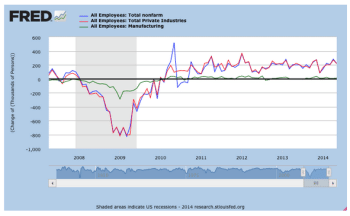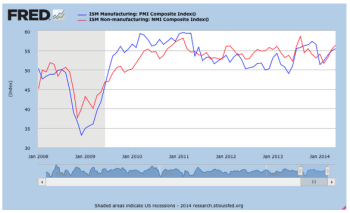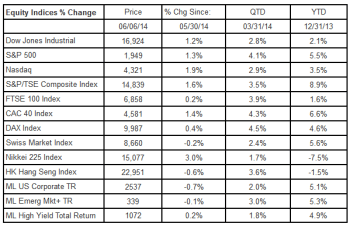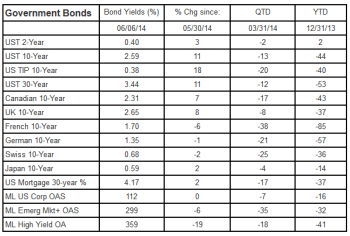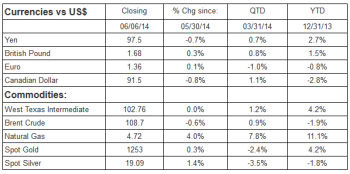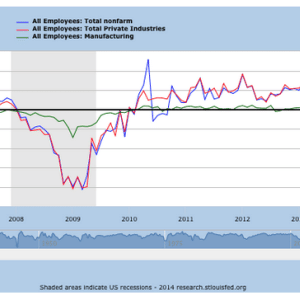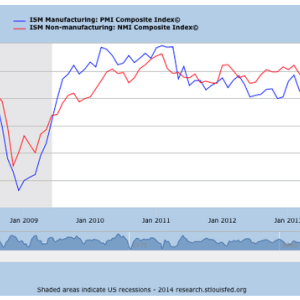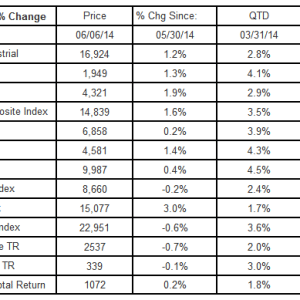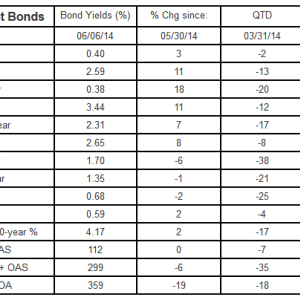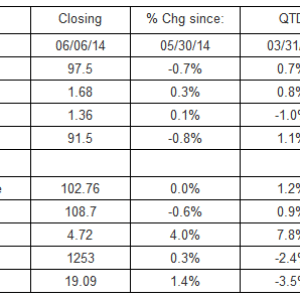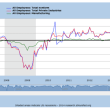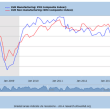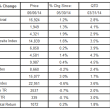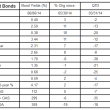John Davidson’s Economic Comments: Week ending June 6
This week's May's reports were on the solid side of the balance sheet. The U.S. Employment report was on the high side of positive expectations. The Purchasing Managers’ Reports were mixed, but most in the U.S. and Europe PMI's remained in the expansion zone. The European Central Bank's actions were more dovish than expected; the Bank of England's actions were as expected; clearly Central Bankers around the globe remained accommodative. In that environment, most equity markets rose. U.S. interest rates rose, but riskier credit spreads narrowed on the week; EU rates fell on the ECB's dovish moves. The U.S. dollar and oil prices were mixed, but natural gas and metals commodity prices rose on the week.
Perspective:
As of this May, the nonfarm payrolls recovered the number of jobs lost in the Great Recession; this task took over six years from the start of the recession to accomplish. How does this compare to past recessions? This weekend, WSJ reporter, Eric Morath, wrote about the May employment report in an article titled, Jobs Returns to Peak, but Quality Lags. One graph in the article compared the change in Nonfarm Payrolls from the start of each recent recession until they returned to pre-recession levels; the graph compared the current recovery to those recoveries of the recessions of 1980, 1981, 1990 and 2001. In contrast to the six+ years of time to jobs recovery for the current recovery: the post-1980 recovery occurred in about a year; the post-1981 and post-1990 recoveries occurred in over two years; the post-2001 recovery took about four years. The second contrast was the depth of the jobs losses. The most recent recovery occurred after a loss of more than 6% of the labor force; the 1981 recession initiated a 3% decline in the labor force; the 2001 recession cost a 2% decline while the 1980 and 1990 declines were just over 1% of the labor force. The severity of the loss and length of recovery of the most recent recession is one reason this recession has been named the "Great Recession."
Moran's issue on quality is that this jobs recovery has favored lower paying jobs in the accommodation and food service sectors while jobs in the higher paying sectors, like manufacturing, construction and government, have shrunk.
While there is no question but that May's Employment Report was positive on the path to recovery. Yet, the milestone that is associated with the length of time necessary to recover the lost jobs is testimony to the severity of the recession and shakiness of the recovery.
Economic Releases:
The earliest and most watched economic indicators of U.S. economic activity in the prior month are the Non-Farm Payrolls and the Purchasing Managers Indicies. Both sets of indices indicated, as expected, continued moderate expansion in the U.S. economic recovery.
NFP's (blue in the chart) increased 217,000; Private Payrolls (red in the chart) increased 216,000; Manufacturing Payrolls (green in the chart) increased 10,000 in May. Net revisions in the NFP for the prior two months decreased NFP by 6,000. The jobs numbers were within the range, but on the high side of expectations for a solid report. In other employment data, the Unemployment Rate remained at 6.3%, the Average Hourly Earnings rose +0.2%, and the Average Workweek remained at 34.5 hours in May. In the week of May 31, the Initial Claims for Unemployment Benefits rose to 312,000; Continuing Claims dropped 20,000 to 2.603 million.
The ISM Purchasing Managers' Index for Manufacturing (blue in the chart) rose a half point to 55.4; the ISM Services Index (red in the chart) rose a point to 56.3 in May. Markit's PMI for Manufacturing rose a point to 56.4; Markit's PMI for Services rose 3 points to 58.1 in May. Both ISM and Markit's Indices remained well in the expansion zone, above 50.
Other Economic Releases
U.S. Motor Vehicle Sales for May exceeded the range of expectations. Domestic Vehicle Sales rose to 13.3 million; Total Vehicle Sales rose to 16.8 million.
The European Central Bank cut its rates after its meeting this week; in fact, the deposit rate was cut 10 basis points to -0.10%, sending a clear message of accommodation, even more dovish than was expected. The Bank of England also met, but kept interest rates and asset purchase levels unchanged at 0.50% and 375 billion pounds.
The European Union's PMI for Manufacturing dropped a point to 52.2; the Markit Composite PMI dropped a half point to 53.5, but its Services PMI increased a tick to 53.2. Similarly, Germany's Manufacturing PMI dropped two points to 52.3; Germany's Markit Composite PMI fell a half point to 55.6; Germany's Markit Services PMI rose over a point to 56.0. France's Manufacturing PMI fell into the contraction zone, at 49.6, as did France's Markit Composite PMI at 49.3 and Services PMI at 49.1.
China's PMI for Manufacturing rose a point to 49.4, but remained in the contraction zone in May; China's HSBC Composite PMI crossed into the expansion zone at 50.2; China's Services PMI fell a half point to 50.7, but remained in the expansion zone in May. Japan's Composite and Services PMI's both rose, but, at 49.2 and 49.3, remained in the contraction zone. Japan's Q1 GDP was revised up a tick to 1.6%, better than expected.
Equities Markets:
Most equity markets rallied on the heels of better economic data and more evidence of accommodation by the Central Bankers. In the table below, only the Swiss and Hong Kong equity markets posted losses on the week. Rising interest rates generated negative returns in the investment grade corporate bond market, but narrowing spreads offered positive returns for high yield bond sectors.
Bond Markets:
Better economic data, especially in the U.S. gave a boost to bond yields. The accommodative European Central Bank at this week ECB meeting pushed yields lower in Europe. High yield and emerging market credit spreads narrowed with the easing of geopolitical risks, but investment grade credits remained unchanged on the week.
Currencies & Commodities:
The U.S. dollar gave ground to the European currencies, but gained against the Yen and Looney. WTI oil prices were flat, but Brent declined on the week. Natural gas and metals commodity prices gained on the week.
John W. Davidson, CFA, started writing these Comments more than a decade ago as a personal discipline when he was promoted from portfolio manager to chief investment officer and CEO.

Most recently, he was the president of PartnerRe Asset Management Corporation, responsible for the management of PartnerRe's invested assets, which grew from $4 billion to $12 billion during his tenure. After joining PartnerRe in the fall of 2001, he hired the staff, built the trading floor and created the infrastructure to manage both fixed income and equity assets internally. He retired from PartnerRe at the end of 2008 and moved to Maine, where he focused on board work.
He has more than 35 years of industry experience, including positions with investment management responsibility for separate institutional accounts, mutual funds, trusts and insurance assets. Prior to joining PartnerRe, he served as president and chief executive officer of two other investment management companies. For various companies he has held positions as chief investment officer, chief economist, head of fixed income and portfolio manager. As a portfolio manager, Davidson managed and traded U.S. Government Securities as well as futures and options on fixed income instruments.
His real world experience is backed by a strong academic foundation, which includes earning a Master of Business Administration in finance and a Master of Arts in mathematics from Boston College, as well as a Bachelor of Arts, cum laude, in economics from Amherst College. He holds the professional designation of chartered financial analyst.
His experiences and credentials have brought him to the public as a television commentator and conference speaker. In addition to his frequent past appearances on CNBC, CNNfn, Bloomberg TV and Yahoo FinanceVision, he appeared as a special guest on Wall $treet Week with Louis Rukeyser. Reuters, Bloomberg and other business press services have quoted his views on the market. He has taught CFA preparation programs, as well as other courses offered by the Stamford and Boston CFA Societies, and the National Graduate Trust Officers' School.
Davidson is a natural leader in both his professional and personal life, having developed those skills early in his career as a naval officer. He spent three years on active duty, which included a year on the rivers of Vietnam, and 24 years in the Naval Reserve, from which he retired as a captain in 1994.
Davidson is treasurer and board member of the Camden Conference. He is also on the investment committee of the Pen Bay Health Foundation. He serves as an independent trustee for mutual funds.
In his leisure time, he is an active sailor, tennis player and skier. With his wife, Barbara, he renovated a 100+-year-old home in Camden, where they enjoy spending time with their two golden retrievers and having visits from their five children. He can be reached at jwdbond@me.com.
Event Date
Address
United States






